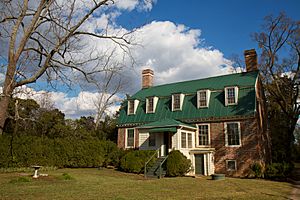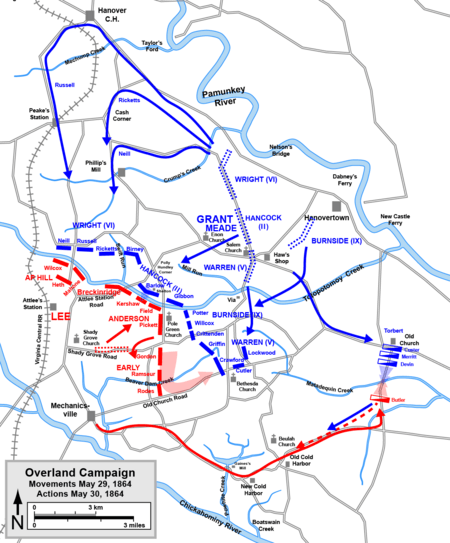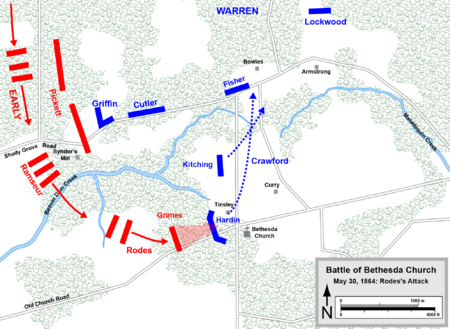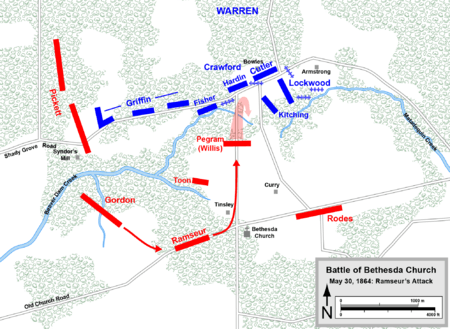Battle of Totopotomoy Creek facts for kids
Quick facts for kids Battle of Totopotomoy Creek(Battle of Bethesda Church) |
|||||||
|---|---|---|---|---|---|---|---|
| Part of the American Civil War | |||||||
 Rural Plains, also known as Shelton House, near Totopotomoy Creek in Virginia. Patrick Henry reportedly married Sarah Shelton in the parlor. The house was near the later unsuccessful advance of Maj. Gen. Winfield S. Hancock's II Corps during the Battle of Totopotomoy Creek in the Civil War. |
|||||||
|
|||||||
| Belligerents | |||||||
| Commanders and leaders | |||||||
| Ulysses S. Grant George G. Meade |
Robert E. Lee Richard S. Ewell |
||||||
| Units involved | |||||||
| V Corps, Army of the Potomac | Second Corps, Army of Northern Virginia | ||||||
| Casualties and losses | |||||||
| 731 total (679 killed and wounded, 52 captured) | 1,593 total (263 killed, 961 wounded, 369 missing/captured) | ||||||
The Battle of Totopotomoy Creek, also known as the Battle of Bethesda Church, was a fight during the American Civil War. It took place in Hanover County, Virginia, from May 28 to 30, 1864. This battle was part of Union Lt. Gen. Ulysses S. Grant's plan, called the Overland Campaign. He was trying to outsmart Confederate Gen. Robert E. Lee's army.
Grant wanted to move around Lee's right side. He hoped to force Lee into a big battle out in the open. Lee, however, saw a chance to attack Grant's advancing troops. He ordered his Second Corps, led by Lt. Gen. Jubal Early, to strike.
Early's soldiers pushed the Union troops back. But a strong defense by Union infantry and artillery stopped their advance. Grant then ordered his other army groups to attack along the Confederate line. This line was dug in behind Totopotomoy Creek. Only one Union group, the II Corps, managed to cross the creek. They were quickly forced back. After the battle, the Union army continued its move southeast, leading to the Battle of Cold Harbor.
Contents
Why the Battle Happened
After a previous battle, Grant's army moved again. They tried to go around Lee's right side. This was part of their ongoing strategy in May 1864. The Union army marched southeast along the Pamunkey River. They hoped to find a weak spot in Lee's defenses.
On May 27, Union cavalry crossed the river. They set up a bridgehead, a secure area, near Hanovertown. As Grant's main army crossed, cavalry from both sides fought. This fight was called the Battle of Haw's Shop on May 28.
Lee's army was in a tough spot. They were dug in behind Totopotomoy Creek. The cavalry fight had given Lee important information. He knew where Grant was heading. However, the Confederates were low on supplies and soldiers. Union attacks had cut off their railroad lines. Lee asked for more soldiers from Gen. P. G. T. Beauregard. Beauregard had 12,000 men nearby. But he first refused, worried about another Union army.
Lee was determined despite this problem. He told Confederate President Jefferson Davis he would fight Grant with his current forces. On May 30, Beauregard finally sent 7,000 men to help Lee.
On May 29, Grant's army moved southwest to face Lee. Grant used his infantry to scout Lee's positions. The II Corps followed a road to the creek. They found Lee's army strongly dug in. So, the Union soldiers started digging their own defenses. Other Union groups spread out to form a long line. The Confederate line was also spread out along the creek. No major fighting happened that day, only small skirmishes.
The battle would take place near the 1862 battlefield of Battle of Gaines' Mill. It was also near Hanover and Bethesda Church.
The Battle Begins
Grant ordered a general attack on May 30. One Union group was to move south against the Confederate left. Another was to attack across the creek in the center. A third group, the V Corps, moved west.
The Union advance was slow. Some troops got stuck in swampy land. Others made little progress against the strong Confederate lines. The V Corps moved across the creek and spread out. They started pushing west along a road.
Lee thought Grant was still trying to go around his right side. He ordered Early's corps to attack the V Corps. Another Confederate group was supposed to help Early. Early planned a surprise attack. His soldiers would march around the Union side and hit them from behind.
As the V Corps moved, its commander, Maj. Gen. Gouverneur K. Warren, worried about his left side. He sent a division to protect it. This division built simple defenses. Around noon, Confederate soldiers attacked this Union division. They broke through the Union lines. The Union soldiers were forced to retreat, exposing their flank.
However, the Confederate attackers lost control. They ran past their targets and became disorganized. Early's plan called for them to push further. But many of Early's soldiers were still marching. Also, the Confederate group that was supposed to help Early was late.
Warren quickly moved his V Corps to face the new threat. The Union soldiers reformed their lines. Artillery arrived and set up cannons. Other Union divisions moved in to support.
Later that day, Maj. Gen. Stephen Dodson Ramseur of Early's corps made a risky charge. He attacked the Union artillery. This attack was not well planned. Other Confederate divisions were not ready to help. Only one brigade actually attacked. They bravely advanced through heavy fire. They got very close to the Union position. But their commander was badly wounded, and the brigade had to fall back.
Ramseur's attack was very costly for the Confederates. But the Union soldiers admired their bravery. One Union soldier wrote that the Confederates' "behavior and bearing during the charge had won the admiration of their captors." A Confederate soldier remembered, "Our line melted away as if by magic."
The Union commander, Maj. Gen. George Meade, ordered a general attack. He wanted to take pressure off Warren's troops. But his other commanders were not ready to attack right away. Warren's men had already gotten out of trouble on their own. The failure of Ramseur's attack discouraged Early. He ordered his corps to pull back.
While the main armies fought, cavalry battled to the east. This was the Battle of Old Church.
After the Battle
The Union army had 731 casualties. This included 679 killed or wounded, and 52 captured. The Confederates had 1,593 casualties. This included 263 killed, 961 wounded, and 369 missing or captured. Two Confederate generals were killed in this battle.
Lee was more worried about new Union soldiers arriving. He learned that 16,000 Union troops were on their way. These soldiers were moving by river to join Grant. If they moved west, they would extend Grant's line too far south. Lee sent his cavalry to secure a key crossroads at Cold Harbor.
On May 31, the Union II Corps crossed Totopotomoy Creek again. But they found that the Confederate defenses were still very strong. Grant realized that the Confederate position was too strong to attack directly. He decided to move his army south toward Cold Harbor that night.
Charles Anderson Dana, a representative with Grant, said:
There was no doubt that Lee's whole army ... was close at hand and strongly entrenched again. Grant ... declared emphatically he would not run his head against heavy works.
Saving the Battlefield
Parts of the battlefield are now protected. The Richmond National Battlefield Park owns and cares for about 124 acres. This area includes the Shelton House and parts of Totopotomoy Creek. It opened to the public in 2011.
The Association for the Preservation of Virginia Antiquities owns 35 acres. This land has many old earthworks near Bethesda Church. The Civil War Trust and its partners have also saved about 132 acres of the battlefield.
Images for kids






